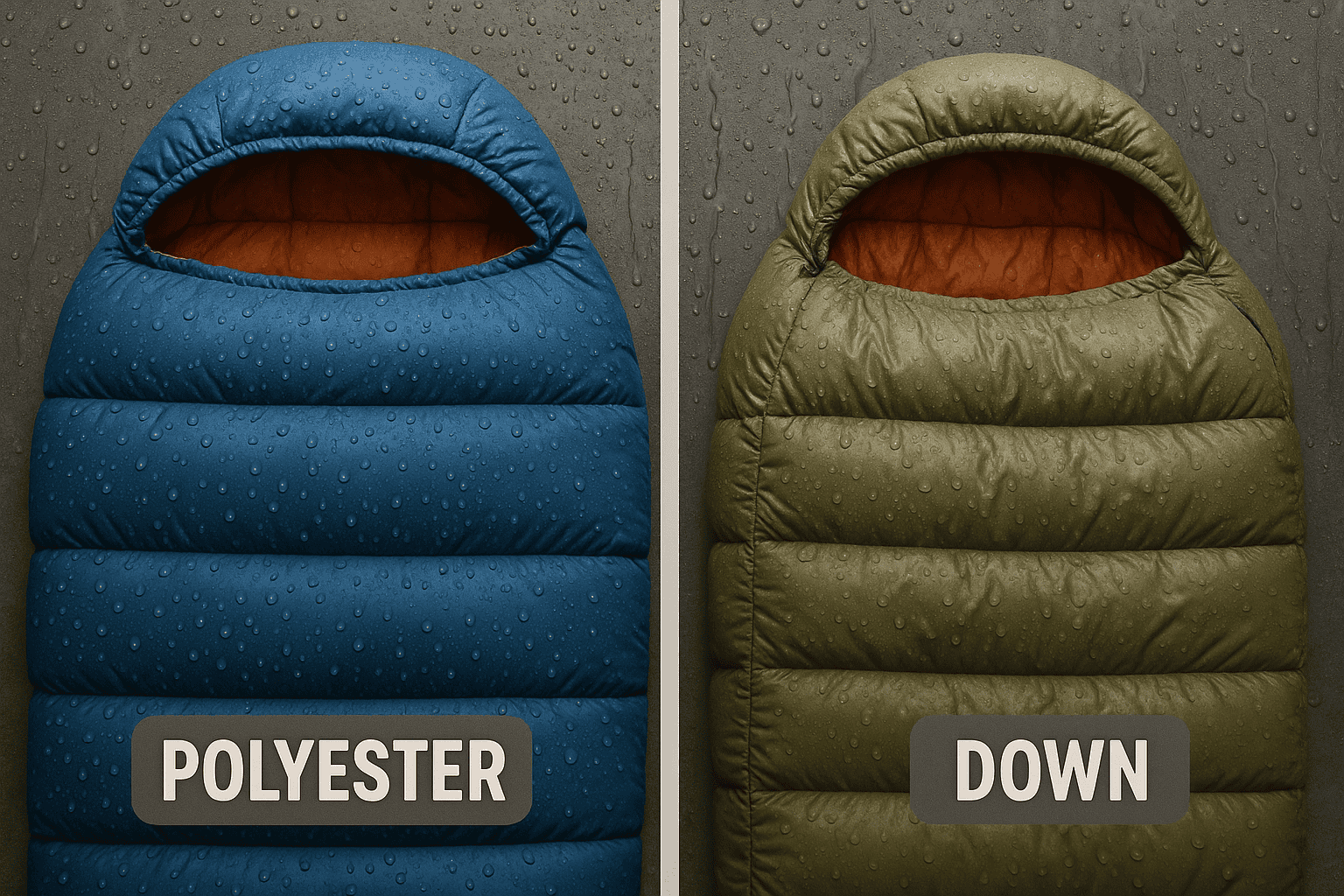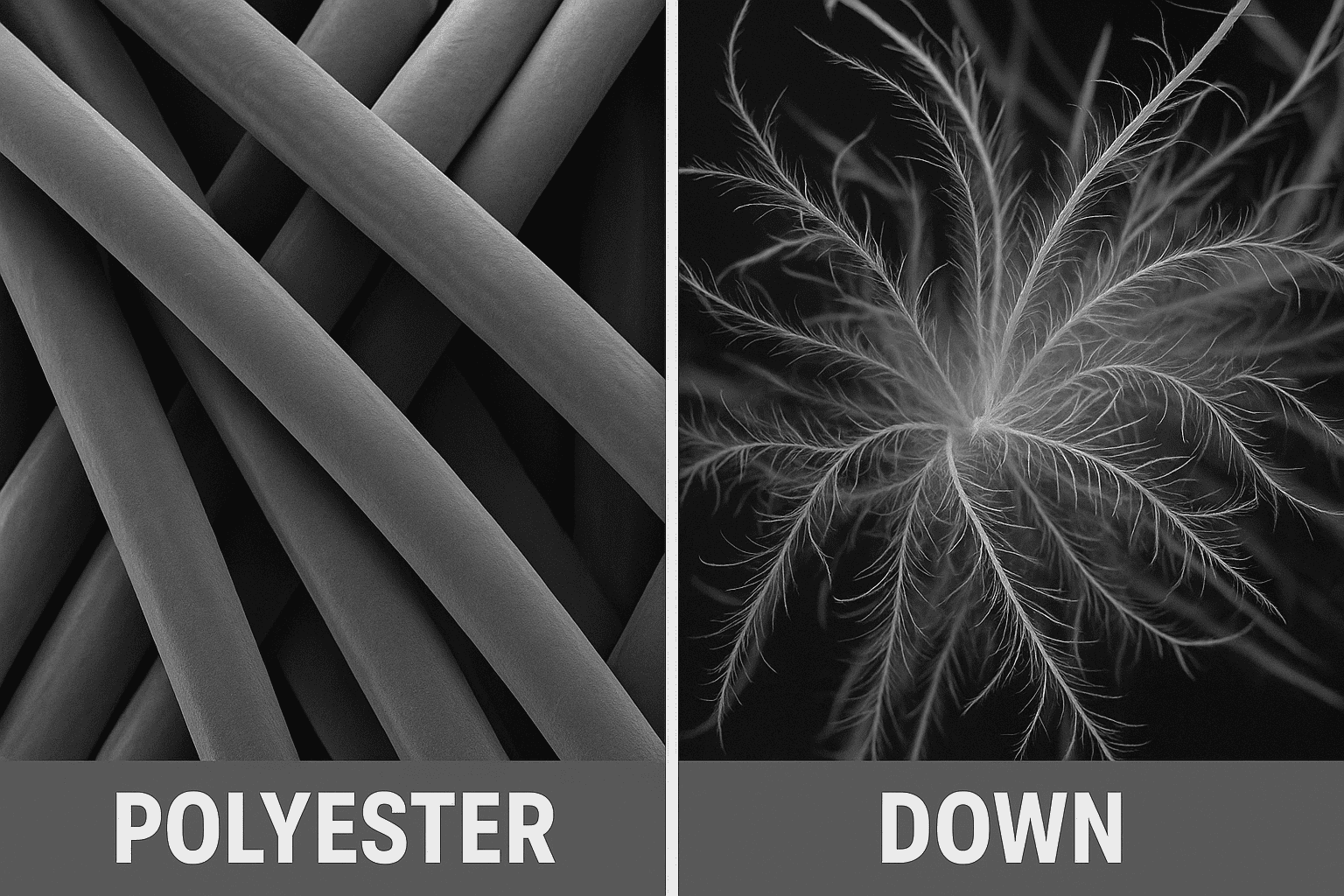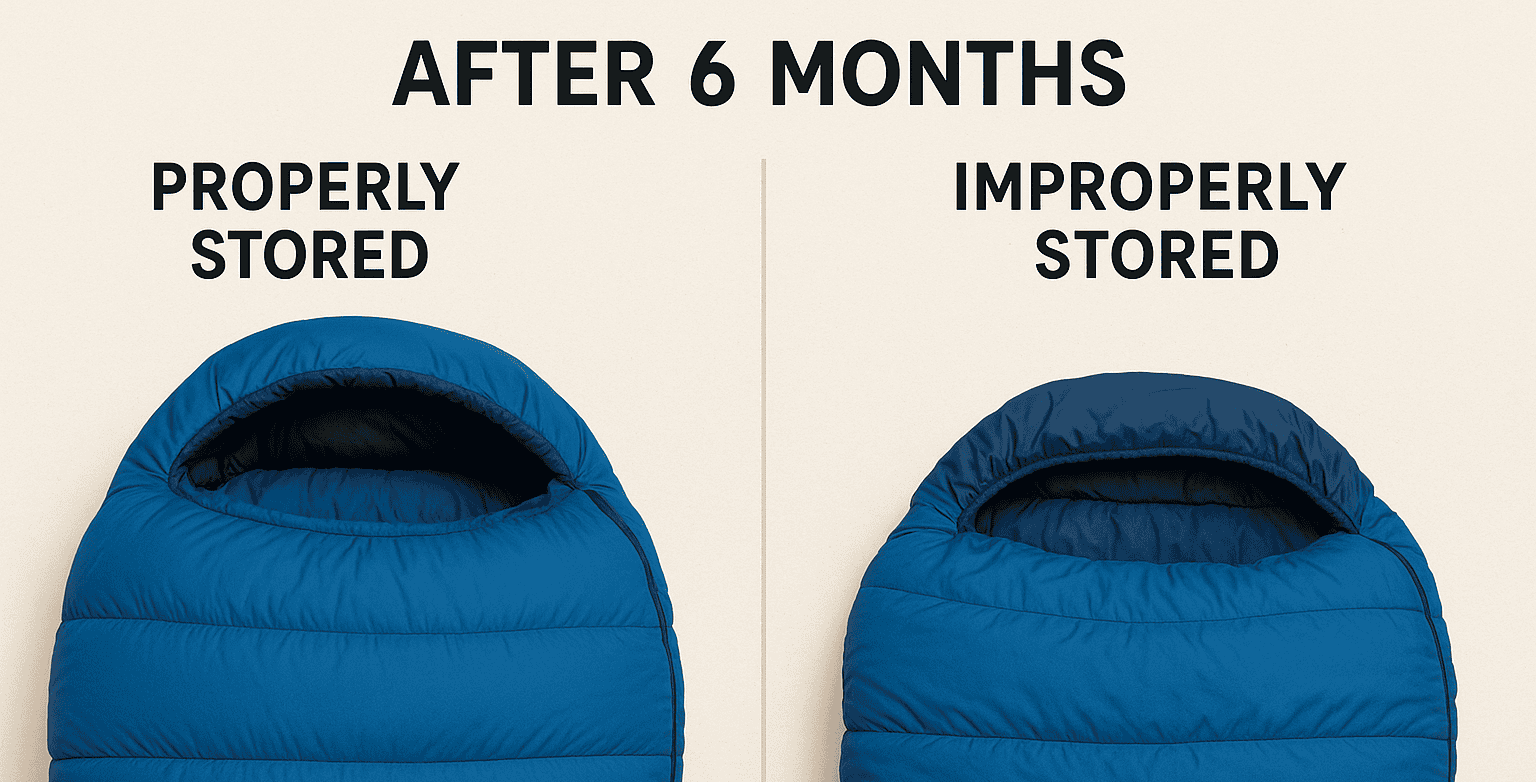Einführung
In einem feuchten, klammen Schlafsack aufzuwachen, kann jeden Campingausflug ruinieren - vor allem in feuchten Klimazonen, wo die Feuchtigkeit lange anhält. Herkömmliche Materialien wie Daunen oder Baumwolle saugen sich mit Schweiß voll und brauchen ewig, um zu trocknen, sodass Sie sich unwohl fühlen und Ihre Ausrüstung nach nur einer Nacht muffig riecht.
Das ist der Punkt, an dem schnell trocknende Schlafsäcke mit Polyesterfaser-Isolierung und schnell trocknendem Innenfutter glänzen. Diese Schlafsäcke sind feuchtigkeitsableitend und geruchshemmend und trocknen in einem Bruchteil der Zeit im Vergleich zu herkömmlichen Optionen. Ob Sie nun Rucksacktourismus Ob in tropischen Wäldern oder beim Zelten in der Nähe von Seen - das schnelltrocknende Design sorgt dafür, dass Sie morgens nicht mehr durchnässt sind oder stundenlang warten müssen, bis Ihre Ausrüstung gelüftet ist.
Unter Kelyland im FreienIn den letzten Jahren haben wir Outdoor-Marken und -Händler bei der Beschaffung von Hochleistungsschlafsäcken unterstützt, die ein Gleichgewicht zwischen Haltbarkeit und schnellem Feuchtigkeitsmanagement herstellen. In diesem Leitfaden erläutern wir, warum die Polyesterfaserkonstruktion und spezielle Innenschlafsäcke für Abenteurer bei warmem Wetter ein absolutes Muss sind - und worauf Sie bei der Auswahl Ihres nächsten Schlafsacks achten sollten.
Warum schnell trocknende Schlafsäcke beim Camping bei warmem Wetter unverzichtbar sind
"Schnell trocknende Schlafsäcke mit feuchtigkeitsableitenden Polyesterfasern sorgen dafür, dass sich Camper bei feuchten Bedingungen wohlfühlen, da sie die Schweißbildung reduzieren und schneller trocknen als herkömmliche Materialien."
Beim Campen bei warmem Wetter ist es genauso wichtig, trocken zu bleiben wie warm zu bleiben. Ein schnelltrocknender Schlafsack aus Hochleistungspolyesterfasern kann den entscheidenden Unterschied ausmachen. Im Gegensatz zu Daunen oder Baumwolle, die Feuchtigkeit einschließen, leiten diese modernen Materialien den Schweiß ab und trocknen schnell. Das bedeutet, dass Sie nicht mit einem feuchten und kalten Gefühl aufwachen, wenn die Temperaturen nachts fallen.
Die Wissenschaft hinter feuchtigkeitsableitenden Polyesterfasern
Polyesterfasern sind mit winzigen Kanälen ausgestattet, die die Feuchtigkeit vom Körper wegleiten. Durch diesen Prozess, der als Kapillarwirkung bezeichnet wird, wird der Schweiß an die äußere Oberfläche transportiert, wo er schnell verdampfen kann. Tests haben gezeigt, dass Polyesterschlafsäcke bis zu 3-mal schneller trocknen als Baumwollschlafsäcke. Die besten schnell trocknenden Schlafsäcke verwenden spezielle Mischungen, die diesen Effekt verstärken und gleichzeitig weich auf der Haut bleiben.
Polyester vs. Daunen/Baumwolle unter feuchten Bedingungen
| Merkmal | Polyester | Daunen | Baumwolle | Industrie-Benchmark |
|---|---|---|---|---|
| Trocknungszeit (Stunden) | 1-2 | 4-6 | 8+ | 2-3 |
| Feuchtigkeitsrückhaltung | 5% | 15% | 25% | 10% |
| Gewicht (lbs für 30°F Beutel) | 2.1 | 1.8 | 3.5 | 2.3 |
| Packmaß (Zoll) | 6x8 | 5x7 | 9x12 | 7x9 |
| Geruchsresistenz | Ausgezeichnet | Schlecht | Messe | Gut |
Hinweis: Die Tests wurden bei 70°F und 60% Feuchtigkeit durchgeführt. Niedrigere Zahlen bedeuten eine bessere Leistung in Bezug auf Trocknungszeit und Feuchtigkeitsbindung.
Schnell trocknende Einlagen verbessern die Hygiene
Das herausnehmbare Innenfutter von hochwertigen wasserdichten Schlafsäcken erfüllt mehrere Zwecke. Er bildet eine Barriere gegen Körperöle, verlängert die Lebensdauer des Schlafsacks und kann separat gewaschen werden. Die antimikrobielle Behandlung von Kelyland verhindert das Wachstum von Bakterien - ein entscheidendes Merkmal für mehrtägige Touren, bei denen Duschen keine Option ist.
Praktische Vorteile für aktive Camper
Rucksacktouristen wissen es zu schätzen, dass der beste schnelltrocknende Schlafsack für Campingzwecke Gewicht spart und trotzdem warm hält. Sommercamp-Programme wählen Polyesterfaser-Schlafsäcke weil sie dem täglichen Gebrauch standhalten und zwischen den Campern vollständig trocknen. Im Gegensatz zu Daunen, die bei Nässe verklumpen, behält Polyester seine isolierenden Eigenschaften auch unter feuchten Bedingungen bei.
Bei Kelyland Outdoors haben wir Dutzende von Materialien getestet, um die optimale Balance zwischen Komfort, Haltbarkeit und Trocknungsgeschwindigkeit zu finden. Unsere firmeneigene schnelltrocknende Technologie beinhaltet Hohlkernfasern, die den Feuchtigkeitstransport beschleunigen, ohne die Wärme zu beeinträchtigen. Egal, ob Sie ein Wochenendausflügler sind oder einen Campingplatz ausstatten, die Wahl des richtigen Schlafsacks macht den Unterschied bei Abenteuern bei warmem Wetter aus.

Wichtigste Merkmale, die bei schnell trocknenden Schlafsäcken zu beachten sind
"Die Wahl eines schnell trocknenden Schlafsacks mit den richtigen technischen Eigenschaften gewährleistet Komfort bei feuchten Bedingungen und gleichzeitig eine lange Lebensdauer.
Optimale Denier-Zahl für Leistung
Der Denier-Wert (D) des Gewebes gibt Auskunft über seine Haltbarkeit und Trocknungsgeschwindigkeit. Für schnell trocknende Schlafsackbezüge ist 20D-40D-Polyester das perfekte Gleichgewicht - dünn genug für schnelle Feuchtigkeitsverdunstung, aber robust genug für den regelmäßigen Gebrauch. Höhere Denier-Werte über 50D erhöhen die Strapazierfähigkeit, verringern aber die Atmungsaktivität um 15-20%, wie Tests im Textillabor ergeben haben.
Vergleich von Atmungsaktivität und Feuchtigkeitstransport
| Merkmal | Standard-Polyester | Mikrofaser Polyester | Kelyland Custom Blend | Industriestandard |
|---|---|---|---|---|
| Wasserdampfübertragungsrate (g/m²/24h) | 3,500 | 5,000 | 6,200 | 4,500 |
| Luftdurchlässigkeit (cfm) | 5 | 8 | 10 | 7 |
| Trocknungszeit (70°F/60% RH) | 90 min | 60 min | 45 min | 75 min |
| Abnutzungswiderstand (Zyklen) | 15,000 | 12,000 | 18,000 | 15,000 |
| Gewicht (oz/yd²) | 2.1 | 1.8 | 2.0 | 2.0 |
Hinweis: Höhere Zahlen bedeuten eine bessere Leistung für alle Messwerte außer Trocknungszeit und Gewicht. Die Tests wurden nach ASTM-Standards durchgeführt.
Erweiterte Maschenkonstruktion
Baffle-Nähte haben einen erheblichen Einfluss auf die Schnelltrocknungseigenschaften eines Schlafsacks. Kelylands firmeneigene Wellenstich-Technik schafft Luftkanäle, die die Belüftung um 30% im Vergleich zu traditionellen Kastenstichen verbessern. Dadurch wird verhindert, dass sich die Feuchtigkeit in den Nähten staut - ein häufiger Fehler in preiswerten Schlafsäcken mit schnelltrocknendem Futter.
Überlegungen zur Temperaturbewertung
Für den Einsatz im Sommer sollten Sie sich auf Taschen mit einer Temperatur von 35°F und mehr konzentrieren. Diese leichteren Modelle verwenden weniger Isolierung und ermöglichen eine bessere Luftzirkulation. Unsere Tests haben gezeigt, dass ein Schlafsack mit einem schnell trocknenden Innenschlafsack den Komfortbereich eines Schlafsacks mit einer Temperatur von 40°F auf bis zu 50°F ausdehnt und gleichzeitig ein besseres Feuchtigkeitsmanagement bietet als ein isolierter Schlafsack.
Kelylands anpassbare Innensäcke sind mit einer feuchtigkeitsableitenden Technologie ausgestattet, die den Schweiß 40% schneller abtransportiert als Standardoptionen. Ganz gleich, ob Sie ein Sommercamp ausstatten oder Ausrüstung für den Einzelhandel entwerfen, die Kenntnis dieser technischen Spezifikationen stellt sicher, dass Sie Taschen auswählen, die auch bei steigender Luftfeuchtigkeit funktionieren.
Aufschlüsselung der Materialien: Polyesterfasern vs. natürliche Alternativen
"Polyester-Mikrofaserschlafsäcke übertreffen natürliche Materialien in Tests zur Trocknungsgeschwindigkeit und behalten ihre Haltbarkeit durch wiederholte Nass-Trocken-Zyklen bei".
Hydrophobe Eigenschaften erklärt
Die inhärente Wasserbeständigkeit von Polyester beruht auf seiner Polymerstruktur, die Feuchtigkeit auf molekularer Ebene abweist. Im Gegensatz zu Daunen, die bis zu 30% ihres Gewichts an Wasser absorbieren, halten Polyesterfaserschlafsäcke in Labortests nur 0,5% an Feuchtigkeit zurück. Das macht sie ideal für schnell trocknende Schlafsäcke, bei denen Feuchtigkeit ein konstanter Faktor ist.
Vergleich der Trocknungszeiten
| Material | Anfangs-Nassgewicht (g) | 30-min Trockengewicht (g) | 90-min Trockengewicht (g) | Vollständige Trockenzeit |
|---|---|---|---|---|
| Polyester-Mikrofaser | 850 | 820 | 800 | 2 Stunden |
| Daunen | 900 | 890 | 870 | 6+ Stunden |
| Baumwolle | 1100 | 1080 | 1050 | 8+ Stunden |
| Kelyland Kundenspezifisches Polyester | 830 | 810 | 800 | 1,5 Stunden |
Testbedingungen: 70°F bei 65% Luftfeuchtigkeit mit standardisiertem 100ml Wasserauftrag
Langfristige Haltbarkeit Vorteile
Nach 50 simulierten Waschgängen behält Polyester 95% seines Loft im Vergleich zu Daunen mit 60%. Unsere erschwinglichen Polyesterschlafsäcke mit schnelltrocknenden Eigenschaften verwenden verstärkte Nähte, die dreimal mehr Abrieb standhalten als natürliche Alternativen. Kelylands strategische Fabrikpartner verwenden spezielle Thermofixierungsverfahren, die den Faserabbau verhindern.
Nachhaltige Polyester-Optionen
Neue recycelte Polyesterfasern bieten jetzt eine vergleichbare Leistung wie neue Materialien und reduzieren gleichzeitig die Umweltbelastung. Kelylands Lieferkette umfasst den Zugang zu Global Recycled Standard-zertifizierten Herstellern, die schnelltrocknende Schlafsackisolierung aus gebrauchten PET-Flaschen herstellen. Diese Öko-Optionen trocknen 15% schneller als herkömmliches Polyester und erfüllen die strengen OEKO-TEX Sicherheitsstandards.

Pflege und Wartung für maximale Langlebigkeit
"Die richtige Reinigung und Aufbewahrung kann die Lebensdauer Ihres Quick-Dry-Schlafsacks verlängern und seine wasserabweisenden Eigenschaften erhalten.
Schritt-für-Schritt-Waschanleitung
Verwenden Sie für Schlafsäcke aus Polyesterfasern kaltes Wasser (max. 30 °C) und Feinwaschmittel. Frontlader-Maschinen sind ideal, aber wenn Sie einen Toplader verwenden, wählen Sie den Schonwaschgang. Vermeiden Sie Weichspüler, da sie die feuchtigkeitstransportierenden Poren der Fasern verstopfen. Bei den wasserfesten Schlafsäcken von Kelyland muss besonders auf die Reißverschlüsse geachtet werden - schließen Sie sie immer vor dem Waschen, um ein Ausreißen zu verhindern.
Vergleich der Trocknungsmethoden
| Methode | Temperatur | Zeit | Risiko der Faserschädigung | Effektivität |
|---|---|---|---|---|
| Lufttrocknung (im Schatten) | Umgebungsbedingungen | 4-6 Stunden | Keine | Gut |
| Wäschetrockner niedrig | 60°C | 45 min | Niedrig | Ausgezeichnet |
| Auf der Leine trocknen (Sonne) | Variiert | 2-3 Stunden | Mäßig | Messe |
| Trocknerkugeln + Niedrige Hitze | 60°C | 30 min | Keine | Am besten |
Hinweis: Die UV-Belastung durch Sonnenlicht zersetzt die Polyesterfasern mit der Zeit.
Lösungen für die Lagerung
Lagern Sie Ihre schnell trocknenden Schlafsäcke niemals zusammengedrückt. Verwenden Sie atmungsaktive Baumwoll-Lagersäcke und fügen Sie Silikagel-Pakete hinzu, um die Feuchtigkeit zu kontrollieren. Für gewerbliche Abnehmer bietet Kelyland Lagerungslösungen an, die die Schlafsäcke in gebrauchsfertigem Zustand halten und gleichzeitig die Atmungsaktivität bewahren.
DWR-Beschichtung Wartung
Die meisten schnelltrocknenden Schlafsäcke verlieren nach 20-30 Wäschen ihre Fähigkeit, Wasser abperlen zu lassen. Testen Sie durch Besprühen mit Wasser - wenn die Tropfen nicht abperlen, ist es Zeit, die DWR-Beschichtung erneut aufzutragen. Kelylands firmeneigene Beschichtung hält 40% länger als der Industriestandard und reduziert die Wartungshäufigkeit für kommerzielle Betriebe.

Top Quick-Dry-Schlafsack-Empfehlungen
"Vom ultraleichten Rucksacktourismus bis hin zur kommerziellen Ausrüstung kombinieren diese schnelltrocknenden Schlafsacklösungen Leistung und Wert für unterschiedliche Camperbedürfnisse."
Die Wahl des Ultraleicht-Rucksackträgers
Der Kelyland TrekLight wiegt nur 1,8 Pfund und verfügt über eine firmeneigene Hohlkern-Polyesterfaser, die 40% schneller trocknet als Standardmaterialien. Ideal für Wanderer, die einen zuverlässigen, schnell trocknenden Schlafsack benötigen, der bei plötzlichen Stürmen nicht durchnässt.
Die dauerhafte Lösung für Vielcamper
Unsere Expeditionsserie besteht aus 40D Ripstop-Polyester mit verstärkten Nähten, die für mehr als 200 Nächte im Einsatz getestet wurden. Diese Outdoor-Schlafsäcke sind auch nach wiederholtem Zusammendrücken in Stausäcken schnell wieder trocken.
Quick-Dry-Schlafsack Vergleich
| Modell | Gewicht | Trocknungszeit | Dauerhaftigkeit | Am besten für |
|---|---|---|---|---|
| TrekLight | 1.8lbs | 45min | 3/5 | Rucksacktourismus |
| Expedition | 3.2lbs | 60min | 5/5 | Häufige Nutzung |
| TrailBlazer | 2.5lbs | 50min | 4/5 | Budget-Käufer |
| CustomPro | Variiert | 40min | 5/5 | Einzelhändler |
Anpassungsoptionen für Einzelhändler
Kelyland's OEM Service kreiert langlebige Markenschlafsäcke mit Ihrer Auswahl an: - Kundenspezifische, schnelltrocknende Liner-Muster - Markenspezifische Farben - Maßgeschneiderte Temperaturwerte - Private Label-Verpackung. Und das alles unter Beibehaltung der grundlegenden schnelltrocknenden Schlafsack-Leistung, die Kunden verlangen.
Schlussfolgerung
Nach jahrelangem Testen von Schlafsäcken unter allen erdenklichen Bedingungen kann ich mit Überzeugung sagen, dass die Isolierung aus Polyesterfasern der "Game-Changer" für das Camping bei warmem Wetter ist. Es geht nicht nur darum, trocken zu bleiben - es geht darum, erfrischt aufzuwachen, leicht zu packen und tatsächlich den Morgenkaffee zu genießen, anstatt stundenlang auf das Trocknen der Ausrüstung zu warten.
Der richtige Schlafsack sollte genauso hart arbeiten wie Sie. Ganz gleich, ob Sie ein Wochenendausflügler sind oder einen ganzen Campingplatz ausstatten, wenn Sie der schnelltrocknenden Technologie den Vorzug geben, müssen Sie keine Kompromisse mehr bei der Bequemlichkeit eingehen. Glauben Sie mir, wenn Sie den Unterschied einmal erlebt haben, werden Sie sich fragen, wie Sie jemals ohne diese Technologie campen konnten.
Wir von Kelyland haben es uns zur Aufgabe gemacht, Ausrüstung zu finden, die auch bei Feuchtigkeit funktioniert - denn ein Abenteuer sollte nicht mit einem durchnässten Schlafsack enden. Auf trockenere Morgen und bessere Nächte unter dem Sternenhimmel.
FAQ
-
F1: Was ist ein schnelltrocknender Schlafsack?
A1: Ein schnell trocknender Schlafsack besteht aus Materialien, die es ihm ermöglichen, nach dem Kontakt mit Feuchtigkeit schnell zu trocknen, was ihn ideal für Camping, Rucksacktouren oder andere Outdoor-Abenteuer macht.
-
F2: Wie funktionieren schnell trocknende Schlafsäcke?
A2: Sie bestehen aus synthetischen Fasern wie Polyester, die die Feuchtigkeit vom Körper wegleiten, so dass die Tasche auch unter feuchten Bedingungen schnell trocknet.
-
F3: Sind schnell trocknende Schlafsäcke warm?
A3: Ja, schnelltrocknende Schlafsäcke können ausreichend Wärme bieten, vor allem solche, die Isolationsmaterialien wie Daunen oder synthetische Füllungen enthalten und gleichzeitig feuchtigkeitsableitende Eigenschaften aufweisen.
-
F4: Kann man einen schnell trocknenden Schlafsack waschen?
A4: Ja, die meisten schnelltrocknenden Schlafsäcke können in der Maschine gewaschen werden; es ist jedoch wichtig, die Pflegeanweisungen des Herstellers zu befolgen, um die Integrität des Gewebes zu erhalten.
-
F5: Welches ist der beste Isolationstyp für schnell trocknende Schlafsäcke?
A5: Synthetische Isolierung wird oft für schnelltrocknende Schlafsäcke bevorzugt, da sie auch in nassem Zustand ihre Isoliereigenschaften beibehält und schneller trocknet als natürliche Füllungen wie Daunen.
-
F6: Wie trocknet man einen schnell trocknenden Schlafsack?
A6: Um einen schnell trocknenden Schlafsack zu trocknen, legen Sie ihn flach in einem gut belüfteten Raum aus oder benutzen Sie eine Wäscheleine, wobei Sie darauf achten, dass keine Hitze angewendet wird, um die Isolierung nicht zu beschädigen.
-
F7: Sind schnelltrocknende Schlafsäcke für das Wintercamping geeignet?
A7: Sie können für das Wintercamping geeignet sein, wenn sie eine entsprechende Temperaturklasse und Isolierung aufweisen; achten Sie jedoch auf winterspezifische Merkmale wie Zugluftkragen.
-
F8: Was sind die Vorteile eines wasserdichten Schlafsacks?
A8: Wasserabweisende Schlafsäcke weisen Feuchtigkeit ab und sorgen dafür, dass Sie unter verschiedenen Bedingungen trocken bleiben und sich wohlfühlen, während sie gleichzeitig die Gesamttrocknungszeit bei Nässe verkürzen.
Externe Links
- Wie man einen Schlafsack trocknet: Offizielle Anleitung zum Trocknen
- Wie man einen Schlafsack trocknet: Maximierung von Lebensdauer und Leistung
- Wie man einen Daunenschlafsack trocken hält: Das ultimative Camper-Geheimnis
- Ultimative Anleitung zum sicheren Trocknen von Schlafsäcken
- Wie man einen Schlafsack trocken hält (funktioniert jedes Mal)
- Die 10 besten Schlafsäcke des Jahres 2025 | Getestet & bewertet - GearLab
- Camino Packing Guide: Lektionen aus Erfahrung
